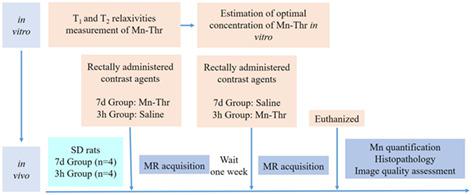当前位置:
X-MOL 学术
›
NMR Biomed.
›
论文详情
Our official English website, www.x-mol.net, welcomes your
feedback! (Note: you will need to create a separate account there.)
Manganese threonine chelate-a new enteric contrast agent for MRI: a pilot study on rats.
NMR in Biomedicine ( IF 2.7 ) Pub Date : 2020-03-16 , DOI: 10.1002/nbm.4293 Yan Luo 1 , Hao Yu 1 , Daoyu Hu 1 , Jiali Li 1 , Xuemei Hu 1 , Zhen Li 1 , Yaqi Shen 1
NMR in Biomedicine ( IF 2.7 ) Pub Date : 2020-03-16 , DOI: 10.1002/nbm.4293 Yan Luo 1 , Hao Yu 1 , Daoyu Hu 1 , Jiali Li 1 , Xuemei Hu 1 , Zhen Li 1 , Yaqi Shen 1
Affiliation

|
Enteric contrast agents are important in gastrointestinal MRI. However, no currently available agent is well established as the standard of care. In this study, in vitro relaxivities of manganese threonine chelate (Mn-Thr), a common nutritional food supplement, were measured at 1.5 T and 3 T with further investigation of its efficacy and safety in vivo as an enteric contrast agent. According to the calculated relaxivities, T1 W and T2 W TSE sequences of Mn-Thr solutions at different concentrations were acquired, and the optimal concentration for dark lumen imaging on both T1 W and T2 W images was determined in vitro. To validate the optimal concentration in vivo, eight Sprague-Dawley rats were randomly divided into two groups. Each group received rectal injection of either 2.00 g/L (about 3.80 mM) Mn-Thr or saline as an enteric contrast agent and underwent MRI. After a time interval of one week, the same procedures were repeated with the alternative contrast agent. Animals were sacrificed after the second MRI. Tissue manganese quantification and histopathological examination were obtained. Qualitative MR image quality assessments were performed and compared between Mn-Thr and saline. Measured T1 and T2 relaxivities of Mn-Thr were significantly higher than those of MnCl2 in vitro (p < 0.05). At the concentration of 2.00 g/L (about 3.80 mM), Mn-Thr produced a dark lumen on T1 W and T2 W images both in vitro and in vivo. Compared with saline, Mn-Thr showed significantly more homogenous luminal signal and increased bowel wall conspicuity in image quality assessments. Tissue manganese concentrations were not significantly different between two groups. Histopathological examinations were normal in both groups. Our data suggest that Mn-Thr possesses favorable paramagnetic properties and can create a homogenous dark lumen on T1 W and T2 W images without obvious side effects in healthy rats. As a commercially available nutritional food supplement, Mn-Thr appears to be a promising enteric contrast agent for MRI.
中文翻译:

苏氨酸锰螯合物-一种用于MRI的新型肠造影剂:对大鼠的一项初步研究。
肠造影剂在胃肠MRI中很重要。但是,目前尚无公认的护理标准可以作为治疗标准。在这项研究中,在1.5 T和3 T下测量了常用的营养食品补充品-苏氨酸锰螯合物(Mn-Thr)的体外弛豫度,并进一步研究了其在体内作为肠造影剂的有效性和安全性。根据计算的弛豫度,获得不同浓度的Mn-Thr溶液的T1 W和T2 W TSE序列,并在体外确定T1 W和T2 W图像上暗管腔成像的最佳浓度。为了验证体内最佳浓度,将八只Sprague-Dawley大鼠随机分为两组。每组接受2.00 g / L(约3。80 mM)Mn-Thr或盐水作为肠造影剂,并进行MRI。在一周的时间间隔后,使用替代的造影剂重复相同的步骤。在第二次MRI之后处死动物。获得组织锰的定量和组织病理学检查。进行了定性MR图像质量评估,并在Mn-Thr和盐水之间进行了比较。在体外测得的Mn-Thr的T1和T2弛豫度显着高于MnCl2(p <0.05)。在2.00 g / L(约3.80 mM)的浓度下,Mn-Thr在体内和体外在T1 W和T2 W图像上产生暗管腔。与盐水相比,Mn-Thr在图像质量评估中显示出明显更高的均匀管腔信号并增加了肠壁显眼性。两组之间的组织锰浓度无显着差异。两组的组织病理学检查均正常。我们的数据表明,Mn-Thr具有良好的顺磁性质,可以在健康大鼠的T1 W和T2 W图像上形成均匀的暗腔,而没有明显的副作用。作为市售的营养食品补充剂,Mn-Thr似乎是有希望用于MRI的肠造影剂。
更新日期:2020-03-16
中文翻译:

苏氨酸锰螯合物-一种用于MRI的新型肠造影剂:对大鼠的一项初步研究。
肠造影剂在胃肠MRI中很重要。但是,目前尚无公认的护理标准可以作为治疗标准。在这项研究中,在1.5 T和3 T下测量了常用的营养食品补充品-苏氨酸锰螯合物(Mn-Thr)的体外弛豫度,并进一步研究了其在体内作为肠造影剂的有效性和安全性。根据计算的弛豫度,获得不同浓度的Mn-Thr溶液的T1 W和T2 W TSE序列,并在体外确定T1 W和T2 W图像上暗管腔成像的最佳浓度。为了验证体内最佳浓度,将八只Sprague-Dawley大鼠随机分为两组。每组接受2.00 g / L(约3。80 mM)Mn-Thr或盐水作为肠造影剂,并进行MRI。在一周的时间间隔后,使用替代的造影剂重复相同的步骤。在第二次MRI之后处死动物。获得组织锰的定量和组织病理学检查。进行了定性MR图像质量评估,并在Mn-Thr和盐水之间进行了比较。在体外测得的Mn-Thr的T1和T2弛豫度显着高于MnCl2(p <0.05)。在2.00 g / L(约3.80 mM)的浓度下,Mn-Thr在体内和体外在T1 W和T2 W图像上产生暗管腔。与盐水相比,Mn-Thr在图像质量评估中显示出明显更高的均匀管腔信号并增加了肠壁显眼性。两组之间的组织锰浓度无显着差异。两组的组织病理学检查均正常。我们的数据表明,Mn-Thr具有良好的顺磁性质,可以在健康大鼠的T1 W和T2 W图像上形成均匀的暗腔,而没有明显的副作用。作为市售的营养食品补充剂,Mn-Thr似乎是有希望用于MRI的肠造影剂。











































 京公网安备 11010802027423号
京公网安备 11010802027423号